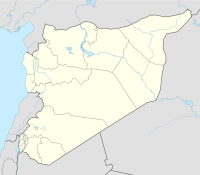 | |
| Location | Homs Governorate, Syria |
|---|---|
| Coordinates | 35°09′00″N 38°49′00″E / 35.15°N 38.81667°E / 35.15; 38.81667 |
| Type | tell |
| History | |
| Material | Flint, Bone, Plaster |
| Founded | c. 7000 BC |
| Abandoned | c. 6500 BC |
| Periods | PPNB, Neolithic |
| Site notes | |
| Archaeologists | Frédéric Abbès Danielle Stordeur Oliver Aurenche Marie-Claire Cauvin |
| Condition | Ruins |
| Management | Directorate-General of Antiquities and Museums |
| Public access | Yes |
Qdeir is a prehistoric, Neolithic Tell and plateau in the El Kowm oasis, a 20 km (12 mi) gap in the Syrian mountains that houses a series of archaeological sites. It is located northeast of Palmyra in Syria, near Al-Sukhnah.
Excavation
The site was tested in 1980 by Olivier Aurenche and Marie-Claire Cauvin, with further excavations between 1989 and 1993 by Danielle Stordeur that are ongoing under Frédéric Abbès. Rectangular buildings with plastered floors and White Ware were found along with various arrowheads, sickle blades and a "desert burin". The collection found at the site has been referred to as a special "desert facies" of PPNB flints.
Culture
The inhabitants of Qdeir are thought to have been nomadic pastoralists who were only part-time farmers from a later Neolithic tradition in comparison to the agriculturalist inhabitants of the village sites of El Kowm. Evidence suggests the location was used as a campsite with only short term occupations deduced from scatters of surface finds. The relationship between the two contemporaneous groups of inhabitants of the area and their behaviors have been discussed by the excavators, who highlight similar construction techniques, use of plaster and basket making. Obsidian, rare stones, stoneware vessels and shells used by both groups also originate from the same places.
Literature
- Aurenche, O. and MC Cauvin., Qdeir 1, campagne 1980: Une installation neolithique du Vile millenaire, 1982.
- Cauvin, Jacques., El Khabra un poste de chasse néolithique du PPNB final de faciès Qdeir (Oasis d'El Kowm, Syrie). Cahiers de l'Euphrate 5-6 47–53. Pans ERC., 1991.
References
- Takeru Akazawa; Kenichi Aoki; Ofer Bar-Yosef (1998). Neandertals and modern humans in Western Asia. Springer. pp. 181–. ISBN 978-0-306-45924-5. Retrieved 24 April 2011.
- Danielle Stordeur (sous la dir.) 2000. El Kowm 2. Une île dans le désert. La fin du Néolithique précéramique dans la steppe syrienne. Par Alison Betts.
- Archorient profile of Frédéric Abbès Archived September 4, 2011, at the Wayback Machine
- Ofer Bar-Yosef; Renée S. Kra (1994). Late Quaternary chronology and paleoclimates of the eastern Mediterranean, pp. 201-203, 361. RADIOCARBON. ISBN 978-0-9638314-1-5. Retrieved 24 April 2011.
- British School of Archaeology in Jerusalem; British Institute at Amman for Archaeology and History, p. 29 (1984). Levant. Council for British Research in the Levant. Retrieved 24 April 2011.
{{cite book}}: CS1 maint: numeric names: authors list (link) - Jacques Cauvin; Trevor Watkins (2000). The birth of the Gods and the origins of agriculture. Cambridge University Press. pp. 195–. ISBN 978-0-521-65135-6. Retrieved 24 April 2011.
- Calley, S., L'Atelier de Qdeir 1 en Syrie : Exploitation des nucléus naviformes à la fin du PPNB, 6e millénaire. Première approche, Paléorient, 1986, Volume 12, Issue 12-2, pp. 49-67.